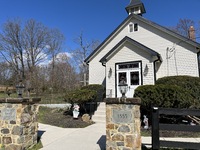Village of St. Louis
The Village of St. Louis (St. Louis) is the third and final community examined in this project. St. Louis is one of the oldest Black communities in Loudoun County, sharing a history similar to that of most of the County. Settled in the first decades following emancipation, the land surrounding what now comprises the Village was purchased over time by Black families, and it grew to become the largest of the Black communities in Loudoun County, at one-point reaching a population of around 200 Black residents.[1] The Black community of St. Louis maintained and remained for many decades throughout the twentieth-century. However, they have long been left underserved by the County – which has only recently begun to acknowledge this.
St. Louis is an example of the modern pressures of development facing many communities in the rural western lands of Loudoun County. Still, it is also a microcosm of the myth of progress. Decades of increasing development, rising taxes, and incoming residents coupled with a century of infrastructural neglect, environmental racism, and lack of acknowledgment by Loudoun County to displace St. Louis in place. These outcomes have combined to replicate similar experiences to those of Tinner Hill and Gum Springs inside St. Louis, who dealt with similar issues decades prior. St. Louis is another community in the displacement lineage built up on the back of progress. Yet they have been able to maintain and remain in the face of development and displacement through banding together to oppose development, and work towards a more stable future in St. Louis with the help of Loudoun County Government.
The primary focus of this section centers on modern and relatively recent encounters of St. Louis with predatory developers and their fight to maintain their community in an era of change in Loudoun. The first section, “Controlled Modernity – Conservation as Progress,” discusses how Loudoun County’s rural landscapes and slower development comport with the myth of progress, and how decades of “controlled development” and ambitions of conservation have created slow violence in Loudoun that has directly impacted St. Louis. The second section, “‘How Can We Live Without Water?’” discusses how neglect and environmental racism intersecting with rising taxes, and predatory attempts at development made possible by controlled modernity have enabled displacement in St. Louis. The final section, “The St. Louis Village Task Force and Loudoun’s Conservation Culture” discusses how St. Louis’s long-time Black residents banded together with new residents and Loudoun County to oppose development by MOJAX LLC and attempt to conserve their land, followed by a discussion on how the culture of conservation in Loudoun County may harmfully reproduce the myth of progress, and fail to address St. Louis’ displacement in place.
[1] Charles P. Poland Jr., From Frontier to Suburbia (Marceline, Mo: Walsworth Publishing Co., 1976): 362-364.
